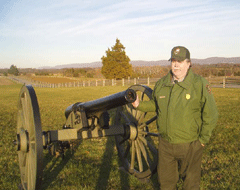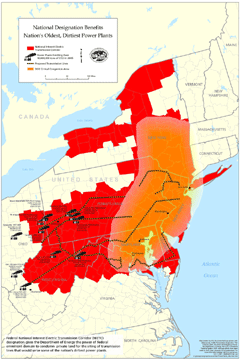Power Struggle
Air Date: Week of January 11, 2008

“The impact is going to be pretty devastating.” Antietam National Battlefield Park Superintendent John Howard says millions in taxpayer dollars went to preserve the view here. (Photo: Jeff Young)
A Department of Energy plan to push for more electric power lines is sparking protest. Opponents say the lines would cut through important natural and historic areas. Living on Earth’s Jeff Young visits a Civil War battlefield to see what might be at stake.
Transcript
CURWOOD: The U.S. Department of Energy is mapping out potential paths to bring power to the people. Officials say these ‘national interest electricity corridors’ will speed construction of power lines needed to meet the increasing demands of energy-hungry Americans and avoid the threat of blackouts.
But some landowners and conservationists don’t like the prospect of massive pylons and cables lumbering across the landscape. They say the power line plan would mar scenic vistas and put the country on a path to more global warming. Living on Earth’s Jeff Young reports.
YOUNG: John Howard looks out on the fields and forests where he works, a place that once saw the single bloodiest day of combat in U.S. history.
HOWARD: The leaves are off the trees, you know, we’re looking out over split rail fences and stone walls towards Antietam Creek over some of the most historic and hallowed ground in the United States.
YOUNG: Twenty-three thousand were killed or wounded here at Antietam, in Maryland. As superintendent of the national park, it’s Howard’s job to keep the Civil War battlefield and its surroundings intact. He’s had help from the state, which spent millions to protect the sweeping view of old farmlands and the forested ridge of nearby South Mountain. Howard says the vista helps visitors connect to their history.

“The impact is going to be pretty devastating.” Antietam National Battlefield Park Superintendent John Howard says millions in taxpayer dollars went to preserve the view here. (Photo: Jeff Young)
YOUNG: Those 19th century soldiers did not look up at high voltage power lines, but Howard fears his visitors might. The Allegheny Power Company wants to get more of its electricity to the Washington and Baltimore areas with a power line through Maryland, and preliminary route maps place it close to Antietam. Howard says that could mean a treeless swath of giant metal towers dominating the view of South Mountain, near where Union and Confederate troops clashed in early skirmishes.
HOWARD: Well I think the impact is going to be pretty devastating. That dirt there is the dirt that these soldiers fought on, bled on, and died on. The idea that it’s not a little bit more important than a power line, I think if we get to that point we’ve lost a lot.
YOUNG: It’s just one of a half dozen power line battles brewing in the Mid-Atlantic and Northeast. Electric utilities want to link their big power plants in the Ohio River Valley to eastern seaboard cities. And natural, historic and scenic areas are often in the path.
State regulators usually handle disputes like this. But this time the federal government might step in. In its 2005 Energy Act, Congress told the Department of Energy to find areas of electricity congestion—that’s where transmission lines can’t deliver all the generated power to consumers. The Energy Department’s Kevin Kolevar says those areas are now national interest electricity transmission corridors.

The red area shows the National Interest Electric Transmission Corridor. The orange area shows the DOE critical congestion area. The black and yellow dotted lines are proposed transmission lines. Finally, the smokestacks mark coal-fired power plants emitting over 10,000,000 tons of CO2 in 2005. (Courtesy of Piedmont Environmental Council)
YOUNG: If states in those corridors fail to approve a power line, the federal government could push for it—even using eminent domain to take property if needed. That has sparked angry protest from governors and attorneys general who say state rights are being trampled. Pennsylvania Democratic Senator Bob Casey complains the Energy Department gave Pennsylvania residents little notice that the designation was coming.
CASEY: I mean, to designate a corridor through 52 counties and have one meeting is beyond obnoxious.
YOUNG: The Energy Department’s mid-Atlantic corridor designation covers seven states from upstate New York through Virginia. Another corridor for the Southwest includes California and Arizona. Now a coalition of two dozen environmental groups is suing the energy department to stop those designations.
Cale Jaffe with the Southern Environmental Law Center says what worries him is not just what’s in the path of the power corridors but what’s at the ends of them. The lines would link to coal-rich regions where it’s easier to get permits for a power plant.
JAFFE: The utility companies are seeking to build power plants where they think environmental rules are most weak. It’s literally an example of running away from our nation’s most progressive environmental protections.
YOUNG: Jaffe says the power lines would encourage new coal power plants and that would mean decades of more heat-trapping greenhouse gas emissions. The legal challenge from his group and others says the government failed to consider other ways to meet power demand, like energy efficiency programs. Some studies show efficiency could reduce projected electricity demand in the mid-Atlantic by as much as a third.
But the energy department’s Kevin Kolevar says while the department supports efficiency, new power lines would still be needed to avoid the threat of blackouts.
KOLEVAR: Efficiency is not in the calculation, nor should it be in this calculation. This is what it is. This focuses on the ability to have the federal government look at new transmission if there is a national interest.
YOUNG: Now it’s up to the federal courts to untangle this power struggle over power lines. For Living on Earth, I’m Jeff Young in Antietam, Maryland.
Links
The US Dept. of Energy has maps and background information on the national interest corridors
Piedmont Environmental Council says the power lines would lead to more pollution
Living on Earth wants to hear from you!
Living on Earth
62 Calef Highway, Suite 212
Lee, NH 03861
Telephone: 617-287-4121
E-mail: comments@loe.org
Newsletter [Click here]
Donate to Living on Earth!
Living on Earth is an independent media program and relies entirely on contributions from listeners and institutions supporting public service. Please donate now to preserve an independent environmental voice.
NewsletterLiving on Earth offers a weekly delivery of the show's rundown to your mailbox. Sign up for our newsletter today!
 Sailors For The Sea: Be the change you want to sea.
Sailors For The Sea: Be the change you want to sea.
 The Grantham Foundation for the Protection of the Environment: Committed to protecting and improving the health of the global environment.
The Grantham Foundation for the Protection of the Environment: Committed to protecting and improving the health of the global environment.
 Contribute to Living on Earth and receive, as our gift to you, an archival print of one of Mark Seth Lender's extraordinary wildlife photographs. Follow the link to see Mark's current collection of photographs.
Contribute to Living on Earth and receive, as our gift to you, an archival print of one of Mark Seth Lender's extraordinary wildlife photographs. Follow the link to see Mark's current collection of photographs.
 Buy a signed copy of Mark Seth Lender's book Smeagull the Seagull & support Living on Earth
Buy a signed copy of Mark Seth Lender's book Smeagull the Seagull & support Living on Earth

